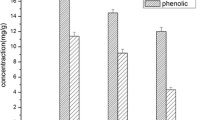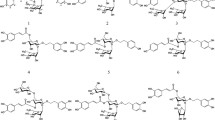Abstract
The antioxidant activity of 10 Japanese and Chinese crude drugs (Kampo drugs) was determined in vitro. Extract of Magnolia cortex, which had the highest antioxidant activity, contained phenolic compounds magnolol and honokiol. However, inhibitory effects of these compounds on lipid oxidation were weaker than that of α-tocopherol as measured by thiobarbituric acid assay. The structure-activity relationship of phenolic compounds showed that antioxidant activities were in the order 4-allyl-2,6-dimethoxyphenol ≥ p,p′-biphenol > eugenol > 2-allyl-6-methylphenol > honokiol > magnolol > caffeic acid > p-ethylphenol > guaiacol. As expected, these results showed that an electron donor and/or bulky groups at the ortho- or para-position of the phenol were required for inhibition of lipid oxidation. Electron spin resonance spin trapping experiments showed that phenol compounds with an allyl substituent on their aromatic rings directly scavenged superoxide (O −2 ), and that only eugenol trapped hydroxyl radicals. These findings suggest that phenolic compounds that contain allyl groups may be effective antioxidants because of the scavenging ability of O −2 or hydroxyl radical, whereas other phenols, without an allyl moiety such as α-tocopherol, may play a role in the termination of free radical chain reactions.
Similar content being viewed by others
References
Reiss, U., and D. Gershon, Comparison of Cytoplastic Superoxide Dismutase in Liver. Heart and Brain of Aging Rats and Mice, Biochem. Biophys. Res. Commum. 73:255–262 (1976).
Schultze-Osthoff, K., A.C. Bakker, B. Vanhaesebroeck, R. Beyaert, W.A. Jacob, and W. Fiers, Cytotoxic Activity of Tumor Necrosis Factor Is Mediated by Early Damage of Mitochondrial Functions, J. Biol. Chem. 267:5317–5323 (1992).
Bragt, P.C., J.I. Bansberg, and I.L. Bonta, Antiinflammatory Effects of Free Radical Scavengers and Antioxidants, Inflammation 4:289–299 (1980).
Fong, L.G., S. Parthasarathy, J.L. Witzum, and D. Steinberg, Nonenzymatic Oxidative Cleavage of Peptide Bonds in Apoprotein B-100, J. Lipid Res. 28:1466–1477 (1987).
Urano, S., M. Hoshi-Hashizume, N. Tochigi, M. Matsuo, M. Shiraki, and H. Ito, Vitamin E and the Susceptibility of Erythrocytes and Reconstituted Liposomes to Oxidative Stress in the Aged Diabetics, Lipids 26:58–61 (1976).
Marubayashi, S., K. Dohi, K. Yamada, and T. Kawasaki, Changes in the Liver of Endogenous Coenzyme Q Homologs, α-Tocopherol, and Glutathione in Rat Liver After Hepatic Ischemia and Reperfusion, and The Effect of Pretreatment with Coenzyme Q10, Biochim. Biophys. Acta 797:1–9 (1984).
Antioxidants-Free Radical and Biological Defence, edited by Niki, E., H. Shimaski, and M. Mino, Gakkai-Syuppan Center, Tokyo, 1994, pp. 3–16.
Okuda, T., Y. Kimura, T. Yoshida, T. Hatano, H. Okuda, and S. Arichi, Studies on Activities of Tannins and Related Compounds from Medical Plants and Drugs. I. Inhibitory Effects on Lipid Oxidation in Mitochondria and Microsomes of Liver, Chem. Pharm. Bull. 31:1625–1631 (1983).
Yoshikawa, T., S. Takahashi, and M. Kondo, Oxygen-Derived Free Radical and Traditional Kampo Medicines, Recent Adv. Cardiopathy Diseases XII:173–181 (1991).
Urano, S., M. Iida, I. Otani, and M. Matsuo, Membrane Stabilization of Vitamin E: Interaction of α-Tocopherol with Phospholipids in Bilayer Liposomes, Biochem. Biophys. Res. Commun. 146:1413–1418 (1976).
Fukuzawa, K., H. Chida, A. Tokumura, and H. Tsukatani, Antioxidative Effects of α-Tocopherol Incorporation into Lecithin Liposomes on Ascorbic Acid-Fe2+-Induced Lipid Peroxidation, Arch. Biochem. Biophys. 206:173–180 (1981).
Yahara, S., T. Nishiyori, A. Kohdo, T. Nohara, and I. Nishioka, Isolation and Characterization of Compounds from Magnolia cortex Produced in China, Chem. Pharm. Bull. 34:2024–2036 (1991).
Hattori, M., M. Tsunezuku, S. Kadota, T. Kikuchi, and T. Namba, Studies on Dental Caries Prevention by Traditional Chinese Medicine. Part V. A Comparison of Antibacterial Action of Magnolol, Honokiol and Related Compounds Against Streptococcus mutans, Shoyakugaku Zasshi 39:76–79 (1985).
Kitagawa, S., H. Fujisawa, and H. Sakurai, Scavenging Effects of Dihydric and Polyhydric Phenols on Superoxide Anion Radicals, Studied by Electron Spin Resonance Spectrometry, Chem. Pharm. Bull. 40:304–307 (1992).
Robak, J., and R.J. Gryglewski, Flavonoids Are Scavengers of Superoxide Anions, Biochem. Pharmacol. 37:837–841 (1988).
Fuzita, Y., K. Togawa, T. Yoshida, T. Hatano, and T. Okuda, Antioxidant Mechanism by Tannins and Flavonoids, Wakan Iyakugaku Zasshi (Japan) 2:647–675 (1985).
Author information
Authors and Affiliations
About this article
Cite this article
Ogata, M., Hoshi, M., Shimotohno, K. et al. Antioxidant activity of Magnolol, honokiol, and related phenolic compounds. J Amer Oil Chem Soc 74, 557–562 (1997). https://doi.org/10.1007/s11746-997-0180-3
Received:
Accepted:
Issue Date:
DOI: https://doi.org/10.1007/s11746-997-0180-3




